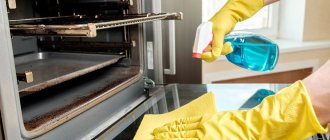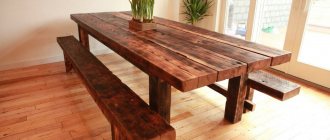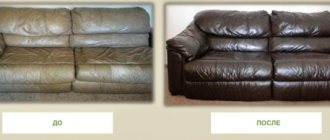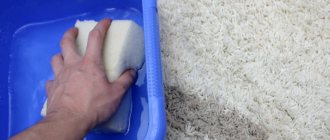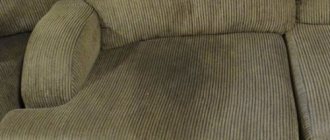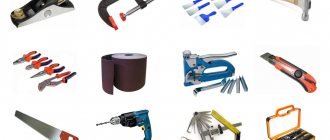Scratches and chips that appear during the use of furniture are not a reason to change the table or chest of drawers. Defects can often be corrected with improvised means or special grouts from stores that do not require special knowledge or training. We reveal the secrets of how to remove scratches from furniture with tea leaves or cosmetic pencil, and what products are suitable for different types of surfaces.
Scratches on furniture
The main causes of scratches
Before you start eliminating scratches, you should find out the reasons for their occurrence. This is necessary in order to prevent the formation of defects in the future. The main reasons include:
- Exposure to abrasive substances, including sand and dust. For this reason, minor and barely noticeable defects appear on lacquered furniture.
- Damage caused by pets' claws or various sharp objects.
- External mechanical influence. The largest and most problematic chips appear from impacts from furniture.
Full painting of tiles
An alternative way to update your bathroom without removing the old tiles is to paint them all over. In addition, this is considered a budget repair option.
To achieve excellent results, pay attention to two important aspects:
- Surface preparation.
- Selecting quality paint.
To carry out all procedures you will need a primer, sandpaper, a roller and paint. The direct painting process can be divided into the following stages:
- Cleaning tiles.
- Degreasing. To do this, wipe the lined area with acetone, alcohol or vinegar.
- Removing the top glossy layer using sandpaper.
- Surface priming. At this stage, you will have to wait about a day until the mixture dries completely.
- Repeated sanding with sandpaper.
- Only after all the preparatory work can you finally apply the paint to the tiles.
- One coat is not enough, so after 12 hours, check whether the paint has dried and repeat application.
How to remove scratches
Detected defects can be removed using improvised or specialized means. If there is serious damage, it is possible to combine several methods.
Special marker
A marker has been created for processing a polished surface, which allows you to restore the attractive appearance of the product. The principle of operation of the marker is the penetration of microparticles into cracks and subsequent filling of the scratch. The marker is colorless and has a consistency similar to paints and varnishes. The applied substance on the surface is not washed off with water and creates protection against new scratches.
Wax
Furniture wax is a universal remedy for removing scratches on wooden products. Wax can be used on laminated and varnished surfaces.
Soft
Soft wax makes the wooden surface smoother and gives the necessary shade to the wood structure. The product does not require pre-mixing and is offered in a ready-to-use state. It is enough to apply wax to the damaged area, remove excess and after 15-20 minutes finish polishing with cotton material.
See also
How to properly lay tiles on the floor with your own hands, installation methods and technology
Solid
The hard type of wax is suitable for restoring wooden furniture with large defects. Unlike soft wax, hard wax is thicker and is applied to material previously melted with a soldering iron. After application, excess material is removed with a spatula, and the coating is thoroughly polished.
Shoe polish
Minor scratches on tables and other furniture can be hidden using shoe polish. It is important to choose a cream that matches the shade of the surface being treated. This method is suitable as a temporary solution to the problem, since after a few wet cleanings the scratches will be visible again.
Brewing black tea
Shallow damage can be masked with an infusion of black tea. Soak a cotton pad in a rich-colored liquid and wipe the damaged areas. The method of removing scratches by welding is suitable for processing dark-colored products.
"Stroke" furniture
A specialized product called “Stroke” was created for application to wood and laminated surfaces. To hide a defect on the surface of a countertop made of plywood, MDF and other materials, you need to select a “Stroke” of the desired shade. The usage process is as follows:
- the coating is pre-cleaned from dust and dirt;
- The product is thoroughly shaken and applied to the surface in several layers;
- 15 minutes after application, wipe the surface with a damp cloth.
Iodine or machine oil
Scratches on dark wood furniture can be removed with iodine or machine oil. It is enough to dip a cotton swab in one of the substances and walk over the defect. When working, you should use rubber gloves to protect the skin of your hands.
Rules of care and preventive measures
When repairing furniture damage yourself, it is very important to remember that the product used should not contain substances that are aggressive to wood or its coating. If you are not sure about the composition, do a small test on an inconspicuous area of furniture.
If the damage is minor, it can be easily removed using home methods.
Perhaps for the prevention and care of furniture you will need additional information:
- Clean furniture regularly, using special products and soft materials.
- Avoid all products containing solvents.
- Ensure optimal temperature and humidity in the room, then your furniture will serve you for many years.
- Dry cleaning using special vacuum cleaner attachments is necessary for hard-to-reach places on furniture.
- If you polish your furniture with mastic once a month, it will look great.
Dry your furniture carefully to avoid scratching it.
If you take preventative measures and care for your furniture carefully and consistently, you can enjoy its presence for a long, long time.
Folk remedies
Various products have become popular among people that also effectively eliminate damage to furniture. Most of the methods described do not require any special costs and are easy to use.
Walnut kernel
When rubbing scratches with a walnut kernel, the damaged area is gradually filled with mass and becomes almost invisible. The procedure can be performed several times in a row to achieve a better effect. It is possible to replace the kernel with nut oil and wipe the scratches by applying the substance to a napkin.
See also
Instructions for repairing a water heater and how to disassemble it yourself
Mayonnaise
The effectiveness of mayonnaise is ensured by its strong penetration into the wood structure. Mayonnaise should be applied to the damaged area several times with an interval of 2 hours. After treatment, the wood will swell and the crack will fill on its own. This method can eliminate defects on any wooden furniture.
Vinegar with vegetable oil
It is recommended to treat light furniture with a mixture of olive oil and vinegar, using the components in a ratio of 5:2. The damaged area is wiped with the mixture and left for a day for complete absorption. Then the furniture is polished with a rag.
Sandpaper
Fine-grained sandpaper helps remove defects on steel furniture elements. The damage is smoothed over with sandpaper and, if necessary, treated with putty. After the material has dried, paint is applied to match the color of the product to mask the area.
Mastic
You can paint over small scratches on wooden products with mastic. The material is distributed on the surface and rubbed with a napkin. To make your own mastic, you need to melt 40 g of wax, add 30 g of turpentine and a teaspoon of alcohol, and then mix thoroughly.
Colored crayons
Colored crayons contain wax, which allows you to paint over scratches. To achieve the desired effect, you just need to choose the right color crayons.
Paraffin
Candle paraffin is kneaded, applied to the damaged area and rubbed until the defect is eliminated. When processing glossy furniture, you need to wipe the surface with a soft cloth after completing the restoration. It is enough to remove the remaining paraffin from the matte surface.
Eyebrow pencil
Applying an eyebrow pencil to scratches can visually hide them.
The disadvantage of using this method is that the pencil wears out quickly, which is why you have to constantly touch up defects on the furniture.
Coffee
By mixing ground coffee beans with a small amount of liquid, you get a semi-thick substance to remove scratches. Apply the substance to the scratches using a cotton swab or disk. You can eliminate defects with coffee only on dark furniture.
Lemon juice and oil
A mixture of lemon juice with vegetable or olive oil in equal proportions is also suitable for treating damaged furniture. The mixed components are applied to a clean, lint-free cloth and the surface is polished, making movements in the direction of the scratch.
Repair of minor damage
Typically, this type of work such as restoration of an artificial countertop involves an initial inspection by a master, followed by procedures for restoring the countertop.
Repair of countertops made of artificial stone is carried out both on site, if the damage is minor, and with transportation to a production facility, if significant intervention is required.
When shallow scratches or stains appear on the surface that cannot be removed, a grinding machine with a fine abrasive wheel will help. Problems such as stains from various chemical detergents and hot burns on the surface, as well as minor scratches, can be removed with your own hands.
Hot pan burn stain removed by sanding
To do this, you will need a polyester compound designed specifically for this purpose. Scratches can be sanded, first with medium, and then with the finest sandpaper. Afterwards it should be polished. Very carefully, slowly and carefully with a soft felt cloth until the original appearance is restored.
Master restorers in this case resort to using a sanding machine with a felt attachment. But when doing DIY repairs, it’s better to use a felt cloth. You need to be careful if the tabletop is made of acrylic with a slight coating of artificial stone. In this case, surface grinding is not performed.
To restore original strength and beauty, work must be performed by qualified specialists. Otherwise, independent intervention in the repair of a surface made of quartz agglomerate may further lead to an increase in the cost of restoration work or to the purchase of a new countertop. Restoring and repairing an artificial countertop is a rather labor-intensive process.
How to hide deep cracks
Very noticeable damage to furniture cannot be easily hidden with improvised means. To restore the original appearance and restoration requires a comprehensive approach to solving the problem.
See also
Step-by-step instructions and rules for applying decorative plaster to walls with your own hands
Preparing the site
Before starting work, you need to thoroughly clean the surface of the furniture from dust and dirt. The cleaned area is coated with a degreasing agent and allowed to dry. Also at the preparation stage, you need to decide what material will be used to hide defects.
Applying the material
The purchased material is applied with a suitable tool or cotton pad to the damaged area. When applying, try to ensure uniformity. Excess material is carefully removed with a spatula.
Grouting the surface
After treating the scratched areas, you need to wipe the surface. During this procedure, the furniture coating becomes smoother and more even. As a rule, fine-grained sandpaper is used for grouting.
Painting
A layer of paint is applied on top of the applied masking material, which matches the color of the rest of the furniture. Paint not only visually hides defects, but also provides additional protection against new damage.
Major damage
If you need expensive repairs of Italian furniture, correction of significant surface damage or complex mechanical breakdowns, you will have to contact a special company that performs furniture repairs at home.
Some serious defects that affect the operational properties of furniture can be corrected independently; local repairs will not cause difficulties for a neat person. Constant changes in temperature and air humidity, characteristic of every working kitchen, cause cracks to appear, and table legs become unusable over time. Repairs should be carried out as soon as possible, before the deformation becomes very noticeable:
- Regular PVA glue is drawn into a medical syringe; for better penetration of the substance, the needle is removed;
- Putting the needle on a full syringe, carefully fill the crack with glue;
- The part is pressed tightly with a clamp, the remaining glue protruding from the crack is removed;
- After a day, the clamp is removed and the repaired part of the furniture is coated with varnish. This will extend the life of the furniture and protect it from further damage.
Putting glue into a syringe
Fill cracks with glue
Clamping the crack
Varnish
Features of working with glass surfaces
In order not to damage the fragile glass surface, you need to take into account a number of nuances during processing. The main rule is to be careful. It is also important to select suitable products that do not harm glass products to complete the work.
Paste GOI
Deep scratches on glass can be removed using GOI paste. If possible, glass should be removed from furniture for ease of processing. A small amount of paste is applied to the fabric and spread over the surface. Then rub the product in a circular motion into the damaged areas. Remains of GOI paste after treatment are removed with a damp cloth.
Nail polish
Minor scratches on the glass coating can be easily masked with nail polish. A prerequisite is the transparency of the varnish. The substance must be applied with a brush to the scratched areas and wait until the varnish fills the crack and dries. The remaining varnish is carefully wiped off the surface with a soft cloth.
"Hatch"
The simplest and most affordable means is a furniture touch
This product is professional. You can find it in stores selling modern fittings. “Stroke” is suitable for masking only small cracks. He can't handle the deep ones. This device is relatively inexpensive. It is intended for laminated, wooden surfaces. The most important thing when choosing a stroke is choosing the right shade. And this device is easy to use.
The stroke is designed for fairly quick repair of small cracks and scratches
Let's look at the process of using it step by step:
- surface preparation. The coating must be cleaned of dirt;
- applying the solution. The “touch” should be thoroughly shaken and applied to the surface. Several layers are needed;
- leveling the coating. Fifteen minutes after application, the surface should be wiped with a damp cloth.
Furniture felt-tip pen is sold in almost all major supermarkets for construction and renovation
Renewing dull polish
During use, polished furniture facades lose their former shine. Spots and scratches appear on them, so the furniture becomes dull. To renew a polished surface, you can use two methods:
- Furniture restoration in a specialized workshop. Masters perform two types of work: restoration of damaged areas and subsequent polishing. This labor-intensive restoration procedure cannot be performed independently without the necessary skills and experience. Specialists remove the top layer of varnish, eliminate all unevenness and dirt, and only then begin polishing. To renew the surface, workshops use special varnish and sanding paper. The final stage is polishing with wax or polishing paste.
- Do-it-yourself polishing. This procedure must be carried out regularly so that the furniture does not lose its shine. To do this, you will need to purchase special products that are used to polish furniture at home. Apply a little polish to the surface and rub thoroughly with a flannel cloth. If for some reason you cannot purchase a special product, you can use linseed oil or white wax.
Polishing is the easiest and most affordable way to update furniture with your own hands. Constant care and careful attitude will allow you to significantly extend the life of polished products.
Furniture decoration
After restoration of furniture, it can be decorated. The following options are usually used:
- Drawings. Can be done manually or using a stencil. Acrylic paints are usually used. It is better to place the ornament around the perimeter, and large drawings - in the lower or central part.
- Decoupage. The most popular are plant or thematic designs.
- Applications made of fabric, wallpaper or self-adhesive film. They can be applied evenly over the entire surface or form a specific composition. For this method, it is necessary to choose a waterproof fabric so that it does not lose its aesthetics.
- Thread. This is done using a sharp chisel and sandpaper. It must be done with caution, since the slab is fragile if its integrity is damaged.
Restored chipboard furniture can be decorated according to your taste and desire.
